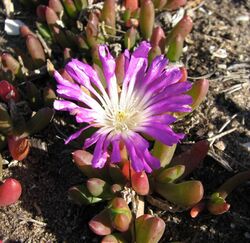Biology:Disphyma
| Disphyma | |
|---|---|

| |
| Disphyma crassifolium subsp. clavellatum | |
| Scientific classification | |
| Kingdom: | Plantae |
| Clade: | Tracheophytes |
| Clade: | Angiosperms |
| Clade: | Eudicots |
| Order: | Caryophyllales |
| Family: | Aizoaceae |
| Subfamily: | Ruschioideae |
| Tribe: | Ruschieae |
| Genus: | Disphyma N.E.Br. |
Disphyma is a genus of flowering plants in the family Aizoaceae that are native to New Zealand, Australia and southern Africa. Plants in this genus are prostrate, annual or short-lived perennial shrubs with succulent leaves and daisy-like flowers arranged singly on the ends of shoots with petal-like staminodes, many stamens and usually five styles.
Description
Plants in the genus Disphyma are prostrate, annual plants or short-lived perennials with branches that root at nodes. The leaves are arranged alternately and fused at the base, succulent and round to more or less triangular in cross-section. The flowers are usually arranged singly, sometimes in pairs or three, on the ends of branches or on short side shoots, each flower on a pedicel up to 100 mm (3.9 in) long. The perianth is tube-shaped with five sepals, two larger and leaf-like and three smaller, slightly succulent and not leaf-like. There are many petal-like, purplish staminodes in two rows and many stamens in four or five rows. The ovary is inferior and there are usually five styles. The fruit is a capsule.[1][2]
Taxonomy
The genus Disphyma was first formally described in 1925 by N. E. Brown in The Gardeners' Chronicle.[3][4]
As at October 2020, Plants of the World Online accepts four species:
- Disphyma australe (Sol. ex Aiton) J.M.Black that is endemic to New Zealand;[5]
- Disphyma crassifolium (L.) L.Bolus that is native to Australia and the Cape Province in southern Africa;[6]
- Disphyma dunsdonii L.Bolus that is endemic to the Cape Province;[7]
- Disphyma papillatum Chinnock that is endemic to the Chatham Islands on New Zealand;[8]
Plants of the World Online also accepts two subspecies:
- Disphyma australe subsp. stricticaule Chinnock that is endemic to Kermadec Island of New Zealand;[9]
- Disphyma crassifolium subsp. clavellatum (Haw.) Chinnock that is endemic to Australia and has been introduced to the South Island of New Zealand.[10]
References
- ↑ Walsh, Neville G.. "Disphyma". Royal Botanic Gardens Victoria. https://vicflora.rbg.vic.gov.au/flora/taxon/2b758014-828d-4076-806c-120bbb6795be.
- ↑ Jacobs, Surrey Wilfrid Laurance; Highet, Jeannie. "Genus Disphyma". Royal Botanic Garden Sydney. https://plantnet.rbgsyd.nsw.gov.au/cgi-bin/NSWfl.pl?page=nswfl&showsyn=&dist=&constat=&lvl=gn&name=Disphyma.
- ↑ "Disphyma". APNI. https://id.biodiversity.org.au/instance/apni/488030.
- ↑ "Disphyma N.E.Br.". Plants of the World Online. https://powo.science.kew.org/taxon/urn:lsid:ipni.org:names:16167-1.
- ↑ "Disphyma australe (Sol. ex Aiton) J.M.Black". Plants of the World Online. https://powo.science.kew.org/taxon/urn:lsid:ipni.org:names:361625-1.
- ↑ "Disphyma crassifolium (L.) L.Bolus". Plants of the World Online. https://powo.science.kew.org/taxon/urn:lsid:ipni.org:names:361626-1.
- ↑ "Disphyma dunsdonii L.Bolus". Plants of the World Online. https://powo.science.kew.org/taxon/urn:lsid:ipni.org:names:361627-1.
- ↑ "Disphyma papillatum Chinnock". Plants of the World Online. https://powo.science.kew.org/taxon/urn:lsid:ipni.org:names:16167-1.
- ↑ "Disphyma australe subsp. stricticaule". Plants of the World Online. https://powo.science.kew.org/taxon/urn:lsid:ipni.org:names:874022-1.
- ↑ "Disphyma crassifolium subsp. clavellatum". Plants of the World Online. https://powo.science.kew.org/taxon/urn:lsid:ipni.org:names:953044-1.
Wikidata ☰ Q2711273 entry
 |

